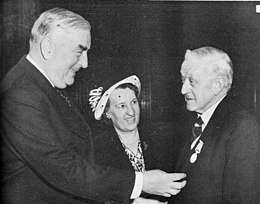Bill Ferguson (cricket scorer)
William Henry Ferguson BEM (6 June 1880 – 22 September 1957) is one of the best-known cricket scorers. For 52 years from 1905 until his death, Ferguson acted as the scorer and baggageman for Australia, England, West Indies, South Africa and New Zealand[1] in 43 tours and 208 Test matches.

He is often credited with two of the most revolutionary innovations in scoring. He developed the radial scoring chart, which shows the directions in which a batsman scored his runs. Originally called "Ferguson's charts", they are now popularly known as "wagon-wheels". He was one of the first scorers to use a linear system of scoring which, unlike the conventional system, keeps track of the balls faced by a batsman and off a particular bowler.[2] In order to record such details, including the times of significant events during an innings, he designed his own scoring books – "which contain[ed] at least twice as much information as any other in the world" – and had them printed at his own expense. At the same time he also filled in a conventional scoring book for official use. He retained his own scoring books.[3]
He received the British Empire Medal in 1951. He scored for the West Indian cricket team in England in 1957 at the beginning of the tour, but had to give up during the tour after a bad fall.[4] He died at his home in Bath, Somerset, a few weeks later.[5] He published his autobiography, Mr Cricket, a few months before his death.
References
- "Bill Ferguson". The Longreach Leader (Qld. : 1923 - 1954). Qld.: National Library of Australia. 5 March 1948. p. 11. Retrieved 7 July 2014.
- Davis, Charles. "The Surviving Test Match Record". Test Cricket in Australia 1877-2002. ISBN 0958109605.
- Bill Ferguson, Mr Cricket, Nicholas Kaye, London, 1957, p. 56.
- The Oxford Companion to Australian Cricket, Oxford, Melbourne, 1996, p. 190.
- "Famous cricket scorer dies". The Canberra Times: 12. 25 September 1957. Retrieved 15 July 2018.
References
- Benaud, Richie (2005). My Spin on Cricket. London: Hodder and Stoughton. p. 278. ISBN 0340833939.
- Biography in The Cricket Country